X-light. It's a term coined by Husqvarna and it's sort of the company's 250F brand. I found this out during a three-day trip to the lava-formed hillsides of the southern portion of Tenerife in the Canary Islands.X-light. I thought it was an awkwardly arranged set of action sports keywords, but their on-the-nose point is obvious: extremely light. I think that's what they really wanted to say. But I also thought this bike was going to be the first 250F with fuel injection, so that tells you what I know.After riding the new bike for a few days, this is what I now know: It's not fuel injected. It has a carb.It's better than the old TC. A lot better. And better pretty much everywhere from motor to suspension to the overall component package.Previous generations of Husky motocross bikes were very slow to rev with a torque-heavy power bias and top-end pull that went on forever. It didn't go on quickly, but it did go on forever. They had an old-school thumper delivery. In today's world of aggressive snap, steep midrange power climbs and instantaneous throttle-to-wheel connectivity, the TCs felt old and slow. They also had great stability, which is a proper way to say they were very heavy-feeling at low speed but unflappable at high speed.Considering the last major update for this model consisted of the removal of an electric starter and battery, I was pretty excited to try out an all-new Husky, and Husky delivered a fairly aggressive package.Centered on reducing weight, the 2009 Husqvarna TC 250 updates start with the motor. It's ridiculously smaller than the previous unit. And even though the previous unit was large for a 250F, the new one seems diminutive for any brand. At a claimed 22 kg (48 pounds), we'd say it's X-light for sure. Throttle response is better and the rear wheel moves with your wrist. But it's still off pace from the class regulars. What it nicely retains is power that loves to be stretched. I realized this as I was being passed by Husky development rider Andrea Bartolini, a fixture in the World MXGPs. I was cruising about halfway to the 13,000-plus rev-limiter a gear high when he went by nearly floating the valves a gear low. So I followed suit and soon enough I was going a lot faster than my short-shifting former self.If, for some lucky reason, you get a TC 250 before we get a test bike in the States and publish a full test in the mag, please believe me that the bike wants more revs. Ride it like a 125 and it will rip. It reminded me of the first couple versions of the KTM 250 SX-F with soft bottom and steady pull. But I think the KTM had the Husky beat in the midrange.While the carburetion is clean through most of the spread, there are some spotty areas where the bike will flutter and bog, especially on hard jump landings or when shifting and letting the rpm drop.Next up is a new frame. Still steel and of traditional structure, it is piggybacked by a minimalistic aluminum subframe and is itself lighter than the old unit. Also, the suspension components are updated to a 50mm Marzocchi fork and an all-new Sachs rear shock. I was quite impressed with the overall suspension movement of the combo. However, the Motocross 365 circuit we rode on (www.motocross365.com) was freeway smooth with nearly zero bumps and/or ruts. So, anything would have felt excellent. But the jump-heavy circuit did offer plenty of opportunity for the ever-hateful overjump monster to appear, and I can assure you the bottoming resistance (even though the initial stroke felt very plush) is well above average.
Other standout features include insanely good brakes, a very decent exhaust tone and a cool, Euro look that will be tricky for installing sidepanel numbers. And the X-light factor truly pays off-even though I mock it often. This bike is a lot lighter than it looks or feels in the pits. In the air, it's easily as flickable as every other bike in the class. The mass centralization is working, and the chassis lends itself to comfortable movements throughout the rider compartment. I actually got a little bit sideways a couple of times-like, the bike's seat sort of stayed with my butt in my butt whip-which is cool.The transmission felt stiff at first and reluctant to shift but loosened up as the hours added up. Likewise, the motor seemed to benefit from a good couple of break-in days with a little boost in power everywhere.There are a few sticky points with the new TC that I hope work themselves out as production starts rolling (we rode preproduction bikes). The starting procedure is archaic. Take, for instance, the fact that the carburetor (which is installed where I was sure an EFI doohickey would be) has a big red knob on it for hot-starting. Handlebar-mounted hot-start levers never sounded so good.Also, the bike must have a 13,000:1 compression piston in it. My first clue came when I tried to kick it and the bike bit back with a return kick to the bottom of my boot. I sought out Bartolini again for guidance, and he gave me a procedure: Find top dead center, go just past it, kickstarter up to the top and kick it all the way through. The fact that there is a procedure-one that's iffy at best in its effectiveness-makes me hope the production versions of these bikes have a hot-start lever and easier starting built in. Oh, the kickstarter sticks between the footpeg and the frame sometimes. I hope that's fixed in production, too.In the end, my quick visit with the newest Husqvarna was a grand one. I can't wait to get a bike back in the States to ride on some real bumps and to put it heads-up against some traditional class contenders.Specifications
MSRP: $6699
Claimed dry weight: 214 lb
Fuel capacity: 1.85 gal.What's Hot!
Light and flickable in the air
Good top-end power
Still very stable at speed
Excellent brakesWhat's Not!
Hard starting
Soft bottom-to-mid power
Carburetion is not perfect2009 Husky TC 250 WEB Impression
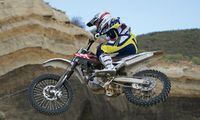
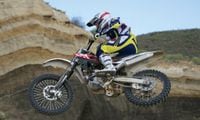
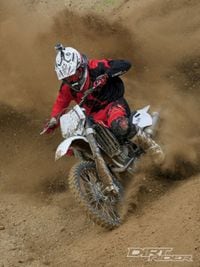
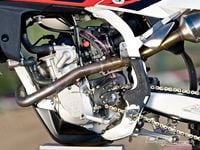



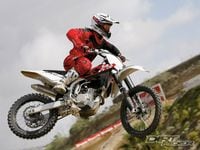
/cloudfront-us-east-1.images.arcpublishing.com/octane/33UTMDHIH5B45HVOLFJ6GD76QY.jpg)
/cloudfront-us-east-1.images.arcpublishing.com/octane/44W4OD5KDZFD3FQWWHZV63P4TY.jpg)
/cloudfront-us-east-1.images.arcpublishing.com/octane/SQ3CEIVCOJF7FDERDVDKKPIC7A.jpg)
/cloudfront-us-east-1.images.arcpublishing.com/octane/LLLQLRK2DBH4PN66MDNA3AFJNY.jpg)
/cloudfront-us-east-1.images.arcpublishing.com/octane/5DMU4K752FBWLLJD432GRAAH2A.jpg)
/cloudfront-us-east-1.images.arcpublishing.com/octane/TGHDVMIODJC4BNKJDZKKTSWXWI.jpg)
/cloudfront-us-east-1.images.arcpublishing.com/octane/5KYMT24REJEFPNO2J2M76MXERM.jpg)

/cloudfront-us-east-1.images.arcpublishing.com/octane/3GXGR3EKSNH5NI3CWHV5SJ7TXE.jpg)
/cloudfront-us-east-1.images.arcpublishing.com/octane/JEU3ONDWEFCAZNAZJOU24OJ2PM.jpg)
/cloudfront-us-east-1.images.arcpublishing.com/octane/JQ6LMK6LLBAQJIL2AH56UIUKWU.jpg)
/cloudfront-us-east-1.images.arcpublishing.com/octane/QUSF4LLRM5DDPCJW25RINQRJPE.jpg)
/cloudfront-us-east-1.images.arcpublishing.com/octane/FYDGK7GF4JBPXERA5RAZPY3YJI.jpg)
/cloudfront-us-east-1.images.arcpublishing.com/octane/JE7KMNASNRGR7FLYAFRZAR7T7E.jpg)
/cloudfront-us-east-1.images.arcpublishing.com/octane/7RCNKJJNXBF4LBKZXE2INNWZUY.jpg)
/cloudfront-us-east-1.images.arcpublishing.com/octane/BAGM5E4EWBHFNLZOXMSLOLKQGU.jpg)
/cloudfront-us-east-1.images.arcpublishing.com/octane/RSX65VBXY5FRLIY4LN6WLOKAFM.jpg)
/cloudfront-us-east-1.images.arcpublishing.com/octane/3EO2CNKWUFBGNMGNJPETW5HCNY.jpg)
/cloudfront-us-east-1.images.arcpublishing.com/octane/IYHM55XRNVHF3DSS3467PZ7ONQ.jpg)
/cloudfront-us-east-1.images.arcpublishing.com/octane/L7K3FIINEBHMZI2TXTUE4FXH7I.jpg)
/cloudfront-us-east-1.images.arcpublishing.com/octane/XE7P5YXNZZDUTIGW4YNWQRDVY4.jpg)
/cloudfront-us-east-1.images.arcpublishing.com/octane/AV55DOHQ3BEXJLPWR6UWLYUSAQ.jpg)
/cloudfront-us-east-1.images.arcpublishing.com/octane/MMROGOYHXZAYDC4RKIDJ4VRSGA.jpg)
/cloudfront-us-east-1.images.arcpublishing.com/octane/FHRWLPEOTBFOHFTQLIHJNIXCFQ.jpg)